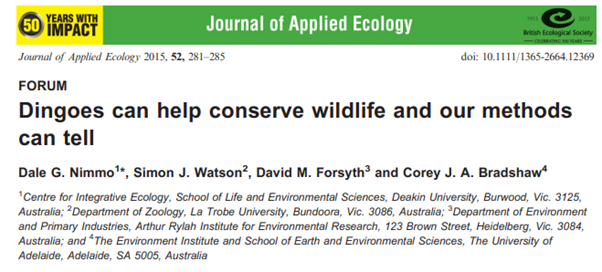(1/14) Great discussion by @RewildingS. This review suggests current methods that investigate the cascading effects of dingoes, as well as the lack of fox and cat eradication, it seems necessary (for such a hot-topic) to also highlight the response to this for interested parties. https://twitter.com/RewildingS/status/1265216378392494080">https://twitter.com/Rewilding...
(2/14) In Nimmo, et al. (2015), they respond that (1) suppression is worthwhile and dingoes can achieve this, and (2) track surveys do have their own merit, and (3) trail-based studies are not necessarily biased.
(3/14) (1) The authors highlight four papers where fox suppression (not eradication) has led to increases in abundance, survival and activity of mammals of conservation concern.
(4/14) Further, using dingoes, instead of baited poison, for suppressing mesopredators can still result in increased mammal abundance - four studies, using a variety of methods, are highlighted to support this.
(5/14) The authors also highlight an overlooked benefit of dingoes or conservation management – their influence on large herbivores, with four papers highlighted. These focus on kangaroos, but could they also apply to introduced herbivores?
(6/14) 2. The authors agree that track-based estimates of carnivore relative abundance really need to be validated, although they highlight examples where track-counts have been shown to quantitatively reflect carnivore abundance - four papers are highlighted.
(7/14) While rigorous methods are obviously what scientists should aim for, the authors remind us of the need to consider fieldwork feasibility and question some suggested gold-standard methods.
(8/14) For example, as these carnivores occur in low densities in remote regions, distance sampling is potentially unrealistic. Track counts, compared to sightings, can be between 5-125 times higher.
(9/14) Scat counts can also be effective and they have been shown to capture variation in population densities - the authors highlight three studies to support this.
(10/14) 3. The authors also call into question the claim that mesopredators always use trails more in the absence of dingoes – highlighting three studies.
(11/14) For example, one study found that foxes actually follow roads for further distances in the presence of dingoes – potentially to locate carrion or prevent ambush.
(12/14) The authors conclude that we need to act to protect many species, and current evidence should not be ignored while waiting for gold-standard experiments that may not be feasible.
(13/14) They argue current research reflects variation in experimental designs, sampling protocols, analytical techniques, and ecosystems, with evidence supporting the benefit effects of dingoes on native mammals.
(14/14) This response wasn& #39;t in line for review at @RewildingS, and thought it deserved to be highlighted!

 Read on Twitter
Read on Twitter


